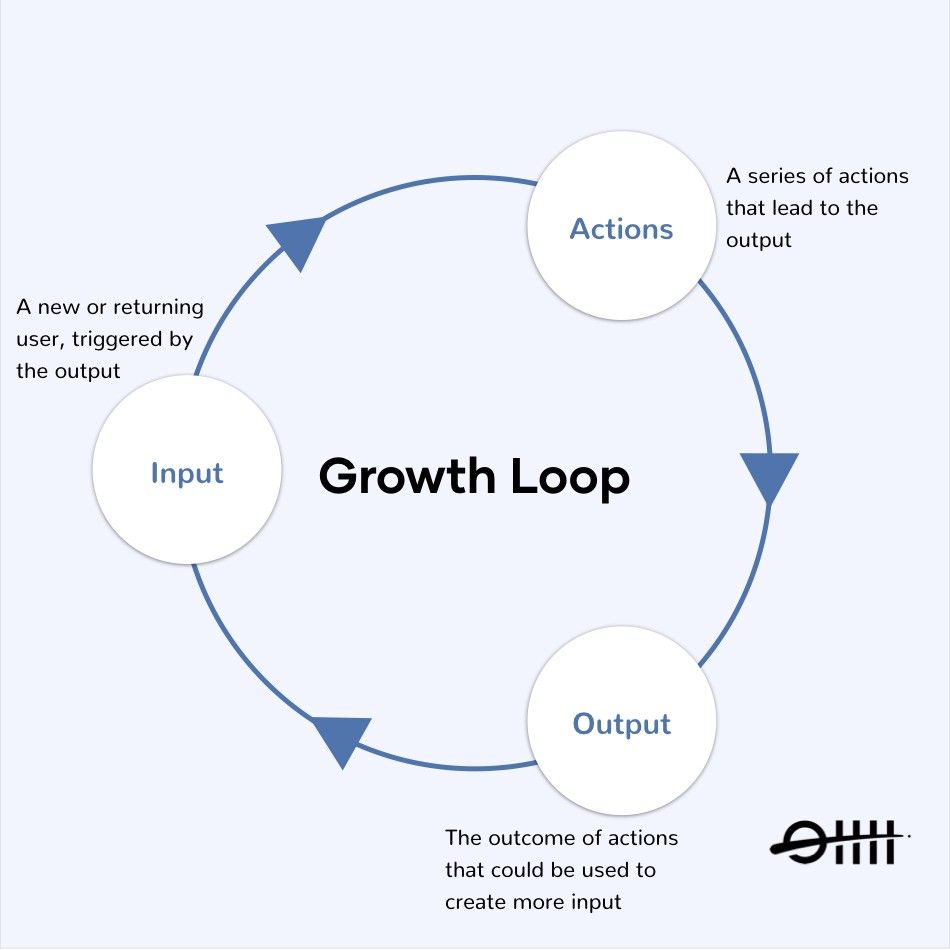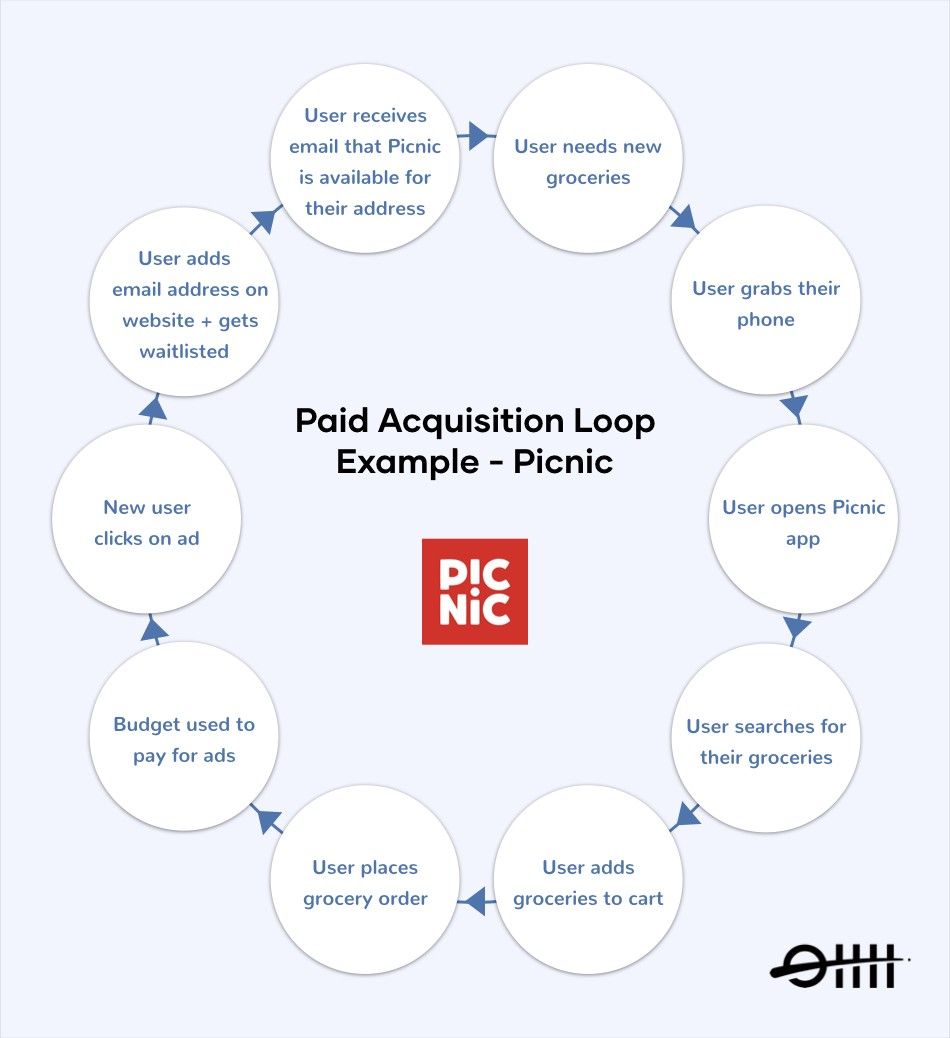Why You Should View Your Business Through A Growth Loop Lense
Putting Growth Loops Into Practice For Picnic
If you want to build a company that grows fast and sustainably, you must consider establishing growth loops within your product. The concept of growth loops was brought to light by the Reforge team in 2018 when they declared that ‘growth loops are the new funnels’. Growth loops are, nonetheless, nothing new. It is merely a name for a pattern spotted at many fast-growing companies. When we observe how the fastest-growing companies around us grow, in most cases, they’ll have one or more growth loops embedded into their products.
Understanding the theory behind growth loops can help us build successful products and services, but how can you go about implementing these loops yourself? I’ll walk you through the key elements of setting up growth loops and how you can make them workable at your company.
Additionally, as a practical example, I dissect the growth loops for fast-growing Dutch company Picnic. I demonstrate how they could strengthen their growth loops further, to inspire you how to do this for your own business.
So, what I’ll cover in this blog:
- What are growth loops and why they are essential to growing a business
- When you should implement growth loops
- How you can put growth loops into practice, using Picnic as an example
By the end of this blog post, I hope to have provided you with knowledge and inspiration to put growth loops into practice at your own company.
What are growth loops?
A growth loop is a cycle of actions that sustain each other. It is when an input (in the form of a new or returning user) leads to an output that can be reinvested into generating more inputs:

Growth loops are essential because they:
- Create compounding growth (which is the most sustainable form of growth in the long term) as opposed to linear growth.
- Look at the entire metrics ecosystem through viewing the interplay between acquisition, engagement and monetisation metrics, as opposed to silo thinking (where product & acquisition strategies are thought about separately).
- Can be more difficult to replicate if explicitly built for your unique company.
There are two types of growth loops that are important to keep in mind when you build a business: acquisition loops and retention loops.
Acquisition loops
An acquisition loop is a system where new users’ actions bring in more new users. Either because they are somehow encouraged to do so, or the revenue a new user has generated can be directly reinvested into new acquisition campaigns. A business can have several types of acquisition loops. The most common acquisition loops are:
- Viral Loops: When existing customers bring in new customers through sharing, inviting, or word of mouth. Great examples are the well-known incentivised referral campaigns by Dropbox, Uber and Airbnb, where their users are prompted to invite their friends in return for discounts. Although if you can get people to talk about your product without needing to incentivise them, even better!
- User-generated Content Loops: When a user finds your product through a search engine, creates more content that gets indexed, and new users find you through that new content. Companies who do this well are, for example, Quora, Wikipedia and Pinterest.
- Paid Loops: When new customers acquired through paid ads, generate revenue that can be reinvested into more paid ads.
- Sales Loops: When new customers acquired through sales activities, generate revenue that can be reinvested into more sales activities.
Ideally, your business has multiple secure acquisition loops. The most powerful loops are organic or through owned channels for increased defensibility. For example, it could be dangerous if you depend on SEO as your sole acquisition loop. As soon as Google changes its algorithm or product, your SEO content loop could be destroyed.
When you need to decide on acquisition channels that are most suitable for your specific business, it can help to create an Acquisition Channel Matrix (use this template). List all the potential channels on the left side, and rank each channel according to criteria such as:
- Cost
- Targeting
- Control
- Input Time
- Output Time
- Scalability
To create sustainable acquisition loops, it’s most important the channel scores high on Scalability. Subsequently, consider the criteria that are most important for your specific business.
Retention loops
Where acquisition loops focus on new users, retention loops focus on returning users. A retention loop is in place when engagement at one moment in time leads to more engagement in another. To establish this, you need to produce retention triggers (e.g. stickiness) and ensure your customers keep experiencing your product’s core value.
Two key examples of retention loop types are:
- Utility-based Retention Loops: When engagement at one moment will encourage engagement in the future. This type of retention loop occurs when the product is a utility, and a user invests into it. For example, when they store data or upload content.
- Network-based Retention Loop: When active users engage with each other, which creates more engagement. This type of retention loop is typically visible on social networks such as Instagram, LinkedIn, and Slack.
Establishing a retention loop is similar to creating ‘stickiness’. Use the ‘Hooked’ model for inspiration for setting up or strengthening your retention loop. Retention loops tend to be strongest when the user forms a habit in one way or another that makes them naturally return to using the product.
When to put growth loops into practice
In the ideal scenario, growth loops are organically embedded in your product design from the get-go, just like you’ll have thought about Product, Market, Channel and Model-fit. However, it’s never too late to start setting them up at a later stage.
In the chart below, you can see what a typical startup growth journey looks like, and at what moments in time you should ideally have established growth loops:

As shown above, a retention loop should ideally be established as early in the Product Life Cycle as possible. You can always strengthen retention loops throughout time. Acquisition loops could be implemented one after the other as the startup grows. For example, the first one could be an organic viral loop, the second one SEO and the third one Paid Acquisition. Having three acquisition loops enhances your defensibility: when one loop stops working, you’ll have two other loops to rely on.
Before setting up multiple acquisition loops, review whether your supply side can deal with a compounding demand. It’d be a pity if you’d have millions of customers knocking on your door and not being able to cater to them.
How to put growth loops into practice
To help show you how to put growth loops into practice at your business, we’re going to use Picnic as an example. I’ll go through how to map out key metrics and how to approach strengthening the loops.

First, a quick introduction of Picnic. This year, the online supermarket Picnic was considered the fastest-growing company of the Netherlands. Only founded in 2015, in just three years the company created nearly 1700 jobs (with the help of €100M in funding received in 2017). Picnic delivers groceries to your home for the lowest price. Because they don’t have any physical stores, they can provide lower costs than traditional supermarkets. Using their mobile app makes doing groceries much more comfortable, and reduces the need for people to go to a physical store.
Please note that Picnic is not a client of ours and the below observations are purely from our own experience using Picnic.
Mapping out key metrics
For each one of your (potential) growth loops, create an overview of the micro-conversions through mapping them out. It helps you understand which metrics are responsible for growing your company the fastest. Knowing their state will show you what you’ll need to focus on.
Through Facebook’s ads library, we see that one of Picnic’s main current acquisition channels is Facebook ads. We do not know whether Picnic has already reached a positive acquisition loop — where the Lifetime Value (LTV) is higher than the Customer Acquisition Cost (CAC). But let’s assume that Facebook ads are a channel with which Picnic could potentially create a paid acquisition loop.
Here is an overview of the essential micro-conversions within Picnic’s paid acquisition loop:

For acquisition loops, having channel attribution is a must to be able to see differences in behaviours of customers coming in through different channels. Ensure you have attribution analytics in place and set up event tracking for important micro-conversions if they are missing.
Viewing your company’s growth through the eyes of growth loops enables you to connect all the critical metrics. We have seen many companies make mistakes in this area, where they would, for example, focus too much on reducing the CAC and forget the conversions beyond that.
Strengthening the loops
After having mapped out the metrics and analysing the micro-conversions within the (potential) loop, you should have a clearer idea of which parameters need to optimise.
Acquisition loops can typically be made stronger by getting new users to experience the core value as soon as possible. Or, if it’s a paid acquisition loop, by ensuring the CAC is less than the LTV within the shortest possible payback period.
Retention loops, on the other hand, can be made stronger through increasing the overall value users experience from using the product (which impacts their likeliness to return).
As an example, let’s take a look at Picnic’s retention loop:

Even though they have been growing fast and have many returning customers, when we delve into their retention metrics in the form of a loop, it gives insights on what they should focus on to further strengthen it. Picnic should look into enhancing the process from needing new groceries to receiving them as much as possible. Their data should provide them with insights on what specific micro-conversions require the most focus.
Without knowing their exact data and drop-offs, some ideas on how they could increase conversions within the loop:
a) To increase conversions from opening the app to adding groceries to the cart; simplify the grocery selection process. E.g. through enabling users to:
- Order a standard grocery selection that they always want to include.
- Order all the ingredients for a meal in 1 click.
- Find their groceries through filters and personalisation — for example, dietary preferences and amount and types of people in the household.
- Order together — for example, for partners, roommates, and colleagues.
b) To increase the conversion from adding groceries to cart to place the order: add more delivery timeslots.
c) To increase conversions from receiving groceries to placing another order through Picnic; expand the range of products on offer.
d) To increase the conversion from needing new groceries to searching within Picnic, provide an alternative to the mobile app to place an order. E.g. a web app, smart home integrations, etc.
The growth loops process never stops
Strengthening your product’s growth loops is an ongoing process so long as your business remains alive. As the world progresses, your business will need to keep on adapting. The only constant thing is change. For acquisition channels, what works today may not work tomorrow. Markets and products evolve, and value creation is all relative. At this point, the people in the Netherlands are satisfied when low-cost groceries are delivered to their doorstep within just a few clicks because they compare it to a visit to the physical grocery store. But it’s not going to take long before people get annoyed that they need to be physically at home to receive the groceries.
And so the cycle of innovation continues… 🔁
